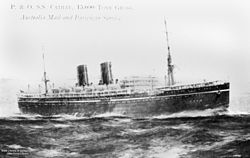Cathay (ship)
|
||||||||||||||||||||||
|
||||||||||||||||||||||
|
||||||||||||||||||||||
|
||||||||||||||||||||||
|
||||||||||||||||||||||
The Cathay (II) was an ocean liner put into service in 1925 by the British shipping company Peninsular and Oriental Steam Navigation Company (P&O), which was used for passenger and mail traffic between Great Britain and Australia and later India . During the Second World War , the Cathay was used as an auxiliary cruiser until she was bombed by German fighter bombers in Bougie on November 11, 1942 , burned out and sank the following day.
Passenger ship
The 15,104 GRT steamship Cathay was commissioned in 1923 together with two identical sister ships . The Cathay and Comorin (15,116 GRT) were built at Barclay, Curle and Company in Glasgow and both launched on October 31, 1924. The third ship, the Chitral (15,248 GRT), was built at the Alexander Stephen and Sons shipyard, also located in Glasgow, and was launched on January 27, 1925.
The three ships each had two funnels, two masts and two propellers and were propelled by two four-cylinder quadruple expansion steam engines with an output of 13,000 PSi and a cruising speed of 16 knots. The ships were designed to carry 203 passengers in the first class and 103 passengers in the second class. The 166.45 meter long and 21.42 meter wide passenger and mail ship Cathay was christened by Jean Paterson Shanks, Baroness Inchcape, the wife of P&O Chairman James Mackay, 1st Earl of Inchcape. The name of the ship was based on an old name in China .
On March 12, 1925, the test drives and the handover to P&O took place and on March 27, 1925 the Cathay set off on her maiden voyage to Australia. In contrast to the Comorin and the Chitral , the Cathay was later not equipped with turbines in order to increase its speed, which was seen as too slow for the Australian postal service. With the introduction of the first P & Os Strath-class ships, the Cathay was relocated to Bombay in 1932 and now also called at ports in the Far East . In November 1933, the ship's tonnage changed to 15,225 GRT or 8746 NRT as a result of modifications. On December 14, 1933, the Cathay lost one of its propellers while trying to make up time between Colombo and Fremantle . She had to wait in Australia for a new propeller to be delivered on board the Strathnaver .
War effort
On August 25, 1939, the Cathay was requested by the British Admiralty for service as an armed auxiliary cruiser (Armed Merchant Cruiser) and converted accordingly in Bombay. The second chimney, which was only a dummy, was dismantled to make room for eight 152-mm cannons and two 76-mm cannons. The ship with the identification F05 was put into service on October 11, 1939 as an auxiliary cruiser and from then on shuttled between Bombay and Durban . From October 1939 to August 1940 she served in the East Indies Station and then in the Freetown Escort Force until November 1941.
In July 1941, the Cathay took on 900 survivors of the Royal Air Force troop transport Anselm (5,954 GRT), which had been sunk by the German submarine U 96 north of the Azores on July 5, 1941 . In December 1941 she was relocated to the South Atlantic Station, but on February 5, 1942, she was released from service as an auxiliary cruiser and returned to P&O. The Ministry of War Transport (MoWT) decided that the Cathay should serve as a troop transport in the future . The necessary renovation work was carried out at the Bethlehem Steel Corporation in Brooklyn .
On November 7, 1942, under the command of Captain Christopher Merewether , the Cathay brought troops ashore west of Algiers for Operation Torch . On November 11th at around 1.30 p.m. she was attacked by German planes, while more troops went ashore in Bougie . The ship was evacuated by 7 p.m. Around 10 p.m., a bomb on board that had been dropped during the attack detonated with some delay. A serious fire then broke out. At around 7 a.m. on November 12th, another bomb detonated and tore open the stern of the ship. The completely burned out Cathay lay down on her starboard side and went down at 10 o'clock at the position 36 ° 44'35N, 05 ° 06'41E. Your crew was transferred to the Karanja of the British India Steam Navigation Company , which is in the same port , but this ship was also bombed shortly afterwards. Ultimately, the crew was brought aboard the Strathnaver .
Web links
- Technical and historical data in the Clydebuilt Ships Database
- Entry in the wreck database
- Information about the Cathay as an auxiliary cruiser on uboat.net

